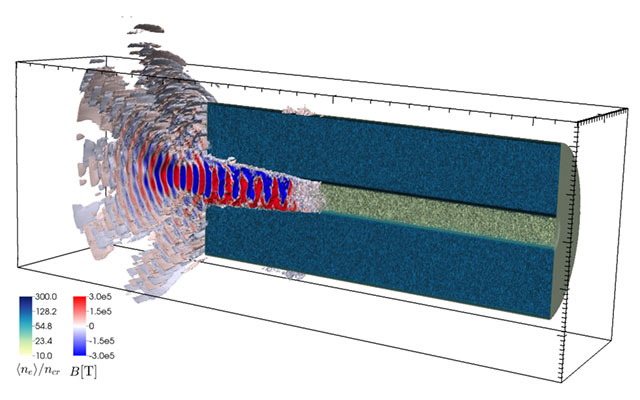News Release
Supercomputers aid in novel simulations of gamma ray generation research
San Diego, Calif., June 17, 2019 -- While intense magnetic fields are naturally generated by neutron stars, researchers have been striving to achieve similar results for many years. UC San Diego mechanical and aerospace engineering graduate student Tao Wang recently demonstrated how an extremely strong magnetic field, similar to that on the surface of a neutron star, can be not only generated but also detected using an x-ray laser inside a solid material.
Wang carried out his research with the help of simulations conducted on the Comet supercomputer at the San Diego Supercomputer Center (SDSC) as well as Stampede and Stampede2 at the Texas Advanced Computing Center (TACC). All resources are part of a National Science Foundation program called the Extreme Science and Engineering Discovery Environment (XSEDE).
“Wang’s findings were critical to our recently published study’s overall goal of developing a fundamental understanding of how multiple laser beams of extreme intensity interact with matter,” said Alex Arefiev, a professor of mechanical and aerospace engineering at the UC San Diego Jacobs School of Engineering.
Wang, Arefiev, and their colleagues used multiple large three-dimensional simulations, remote visualization, and data post-processing to complete their study, which showed how an intense laser pulse is able to propagate into the dense material because of its relativistic intensity.
In other words, as the velocity of the electrons approaches the speed of light, their mass becomes so heavy that the target becomes transparent. Because of the transparency, the laser pulse pushes the electrons to form a strong magnetic field. This strength is comparable to that on a neutron star’s surface, which is at least 100 million times stronger than the Earth's magnetic field, and about one thousand times stronger than the field of superconducting magnets.
The findings were published in a Physics of Plasma journal article entitled “Structured Targets for Detection of Megatesla-level Magnetic Fields Through Faraday Rotation of XFEL Beams” and was recently named “Editor’s Pick”.
“Now that we have completed this study, we are working on ways to detect this type of magnetic field at a one-of-a-kind facility called the European X-Ray Free Electron Laser (XFEL), which encompasses a 3.4- kilometer-long accelerator that generates extremely intense x-ray flashes to be used by researchers like our team,” explained Arefiev.
Located in Schenefeld, Germany, the European XFEL is the working place of Toma Toncian, where he leads the project group construction andcommissioning of the Helmholtz International Beamline for Extreme Fields at the High Energy Density instrument. He is also a co-author on the recently published study.
“The very fruitful collaboration between UC San Diego and Helmholtz-Zentrum Dresden-Rossendorf is paving the road to future high impact experiments,” said Toncian. “As we pass nowadays from construction to commissioning and first experiments, the theoretical predictions by Tao Wang are timely and show us how to further develop and fully exploit the capabilities of our instrument.”
According to Mingsheng Wei, a senior scientist at the University of Rochester’s Laboratory for Laser Energetics and co-author on the paper, “the innovative micro-channel target design explored in the simulation work could be demonstrated using the novel low-density polymer foam material that is only a few times heavier than the dry air contained in micro-structured tubes.”
“Because the resulting data sets of our experiments using XFEL are very large, our research would not have been possible on a regular desktop – we could not have completed this study without the use of XSEDE supercomputers,” said Arefiev. “We are also very grateful to the Air Force Office of Scientific Research for making this project possible.”
Arefiev said that their group’s supercomputer usage efforts relied upon the guidance of Amit Chourasia, SDSC’s senior visualization scientist, who helped set up remote parallel visualization tools for the researchers.
“It is fantastic to work in tandem with research groups and equip them with powerful methods, tools, and an execution plan that in turn propels their research at an accelerated pace with aid of HPC and visualization, it we’re grateful to play a role in enabling new discoveries,” said Chourasia.
This research was supported by the U.S. Air Force Office of Scientific Research under grant number FA9550-17-1-0382 and the National Science Foundation under grant number 1632777. Particle-in-cell simulations were performed using EPOCH and developed under UK EPSRC grant numbers EP/G054940, EP/G055165, and EP/G056803. High- performance computing resources were provided by the Extreme Science and Engineering Discovery Environment (XSEDE) under grant number PHY180033.
Media Contacts
Liezel Labios
Jacobs School of Engineering
858-246-1124
llabios@ucsd.edu
